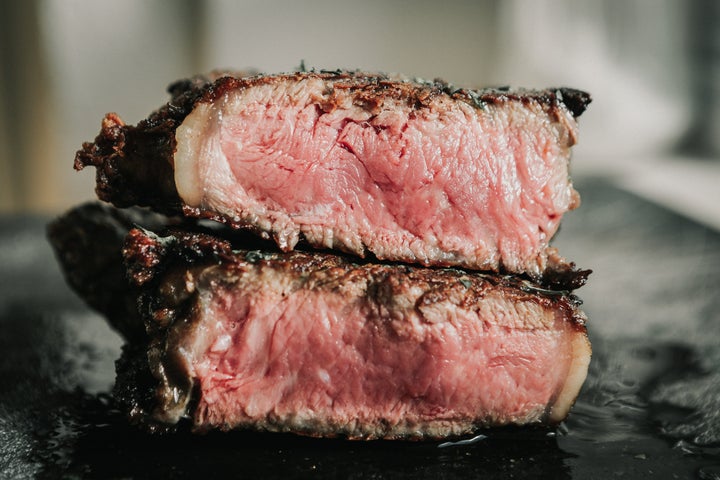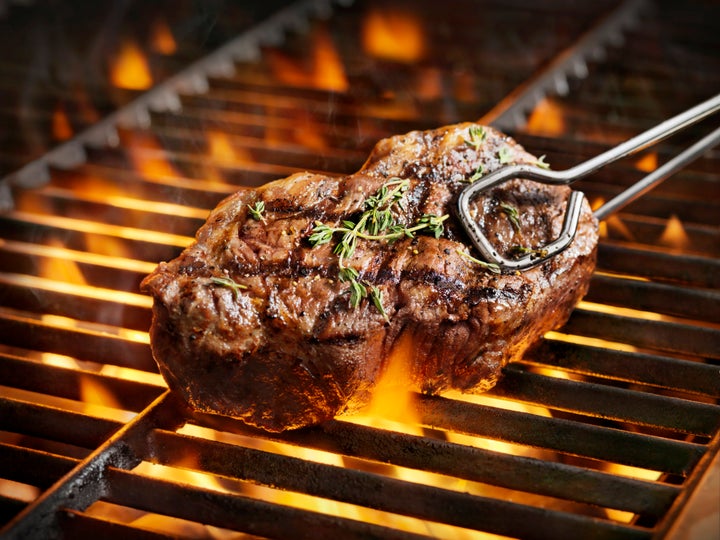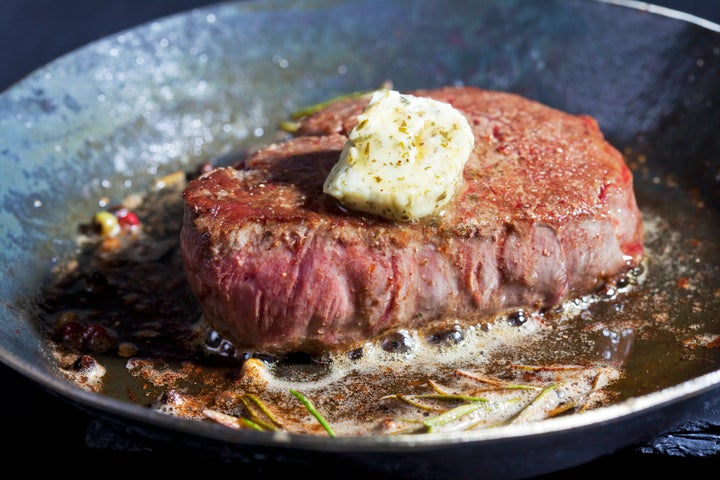Experts share how to cook with a wood fire and on a gas grill, plus how to execute a reverse sear.
What if we told you that you can have a restaurant-quality steak at home? Steak is one of those proteins that seems intimidating to prepare, but it’s actually completely attainable with a little forethought and tips from experts.
Below are three easy ways to make a mind-blowingly delicious steak at home.
Choosing Your Steak
It starts with choosing the right cut of meat, which is entirely up to you.
“The best steaks come from beef that’s 22 to 24 months of age, that in my opinion, are USDA prime Angus cattle,” said of Pat LaFrieda Meat Purveyors, which sells to restaurants and consumers.
That said, there are budgets and options to keep in mind when shopping at the grocery store. For John Castellucci, executive chef of Cooks & Soldiers in Atlanta, it’s a matter of discernment. The USDA prime, choice and select distinction is voluntary for cattle farmers (and not all farms can spring for the certification, though all are inspected), so if he’s at Whole Foods, Castellucci will opt for prime. If he’s at a farmer’s market, though, where a small purveyor may not be graded, he looks at the color of the meat, the marbleization and if the farm is labeled. He also prefers grass-fed and grain-finished beef, which he finds to be more flavorful.
“For me, I try and look for more so a farm that either I’ve heard of or I know is local, or a producer or a vendor that I know only works with really high quality farms,” Castellucci said.
When you bring the steak home, LaFrieda suggests removing it from its packaging and storing it in the fridge in either butcher paper ― which he says is best ― or layers of paper towels, if you don’t have butcher paper. “That will get the best amount of oxygen to the collagen. And that really breaks down the collagen, making a much more tender steak, and will help in the cooking process,” LaFrieda said. He said the steak will keep that way in your fridge for up to a week at 36 degrees Fahrenheit.
Many chefs prefer to take steak out of the fridge between 20 to 60 minutes before cooking it, because if you want your meat to cook evenly from edge to center, it should be close to room temperature. LaFrieda has concerns about food safety, though, and prefers to leave it in the fridge until it’s time to cook the steak. Food safety aside, Serious Eats reported that letting the steak come to room temperature does nothing for the cooking time, anyway. So it’s up to you whether you want to leave it in or take it out, as long as you follow food safety guidelines (you should never let perishable foods sit at room temperature for more than two hours).
Here are three methods to try the next time you’re feeling carnivorous.
1. Wood-Fired Steak

Castellucci specializes in wood-fire grilling at Cooks & Soldiers, and that’s the method he prefers at home, too. “It’s really minimalist. You can use wood fire for a lot of really basic grill setups. Even if you have a sheet pan rack and some bricks, you can create a wood fire grill setup anywhere, whether it’s in the woods or at home,” Castellucci said. Once you have your grill set up, Castellucci suggests using a blend of oak and hickory wood chips for a nice flavor profile that doesn’t burn too quickly.
If he’s grilling a steak at home, it’s likely a ribeye.
Start the grill about 30 to 45 minutes before you plan to cook, so the wood has time break down into coals. Then Castellucci creates a side of the grill that has indirect flames (the flame will be on the other side of the grill). “What that allows me to do is just to get a really nice, hot crust on the steak without getting direct flame, which is going to create that carbon flavor profile,” he said. “When you get that really, really hot crust, it’s going to create the Maillard reaction with the proteins.”
Before placing your steak on the grill, make sure the grates have time to get completely hot. You don’t want to use oil (this could cause a flare up), and if the grates aren’t hot enough the steak could stick, he said. Also, don’t go wild with the seasoning: Castellucci prefers to keep it simple with coarse sea salt rubbed into the steak in lieu of steak seasoning, which allows the meat’s flavor to shine.
Once the steak is on the grill, Castellucci will cook it eight to 10 minutes on the first side, assuming it’s a 3- to 4-inch steak. He does quarter rotations every two to three minutes and then flips the steak after eight to 10 minutes.
To see if the steak is done, you can use a digital meat thermometer. A medium-rare steak will be ready between 130-140 degrees Fahrenheit.
When the steak is ready, Castellucci pulls it and places it on a resting rack, which allows the muscle fibers to relax before slicing it. Aim for about seven to eight minutes, he suggested.
2. Gas Grill

LaFrieda prefers to use the gas grill for his steak. To start, he’ll turn on his grill and close the top cover, letting it reach 700 degrees F (or as close as possible). Then he takes his steak from the fridge to the grill immediately and doesn’t close the grill again. “Because the natural water that’s in the steak that needs to escape, you don’t want that steaming steak,” LaFrieda said. “You really just want the part that’s facing the flame to cook.” Once he does the final flip, he shuts the grill off because it doesn’t need any more heat.
During the cooking process, LaFrieda flips the steaks twice make sure he has a good sear. He only flips the steaks with tongs to avoid puncturing the meat. “Then I take those steaks right off when the interior temperature reaches about 120. So at 120, I want to pull those steaks. And then I put them on the plate with aluminum foil over them. And I let them sit for a good six minutes,” he said.
For this method, LaFrieda was picturing a porterhouse steak, but it could work with a ribeye, flat iron, hanger, etc. If he’s cooking a skirt steak, he’ll marinate it first to add flavor and aid in the caramelization.
3. Reverse Sear

Demetra Overton, the chef behind Sweet Savant, is a fan of the reverse sear method, which involves an oven and a cast iron skillet.
She likes to start with a cut of steak at least 2 inches thick ― maybe a porterhouse or ribeye.
Coat the steak with salt, and then place it on a wire rack on a rimmed baking sheet and put it in the oven at 225 degrees F. “That hot air can circulate around it and give us a nice dry outside of that steak,” Overton said. If you’re feeling really fancy, Overton said you can season the steak, put it on the rack and place it in the fridge overnight, which will dry it out even more. “The dryer your steak is, the better crust you’re going to get in the end,” she said.
The steak stays in the oven for about 20 minutes if you want it to be rare (105 degrees) and a little bit longer for medium rare (115 degrees). Overton said to pull the steak from the oven before it reaches its final temperature because the cast iron skillet is going to raise the temperature.
Put the cast iron skillet over high heat and add a little bit of neutral oil (seriously, just a teaspoon or so). If the steak seems moist, feel free to pat it down with a paper towel. “Just get any moisture off, because moisture is the enemy of the crisp crust that we want,” Overton said.
Cook the steak for two minutes on each side and use your tongs to stand it up on its side and get the edges, too. The day before cooking the steak, Overton likes to prepare a compound butter with shallots, parsley, thyme, rosemary, etc. “Once you finish searing the steak, you can turn the heat off and top it with that compound butter and just spread it around, melt it on both sides, and you’re good to go,” Overton said.
Credit: Source link